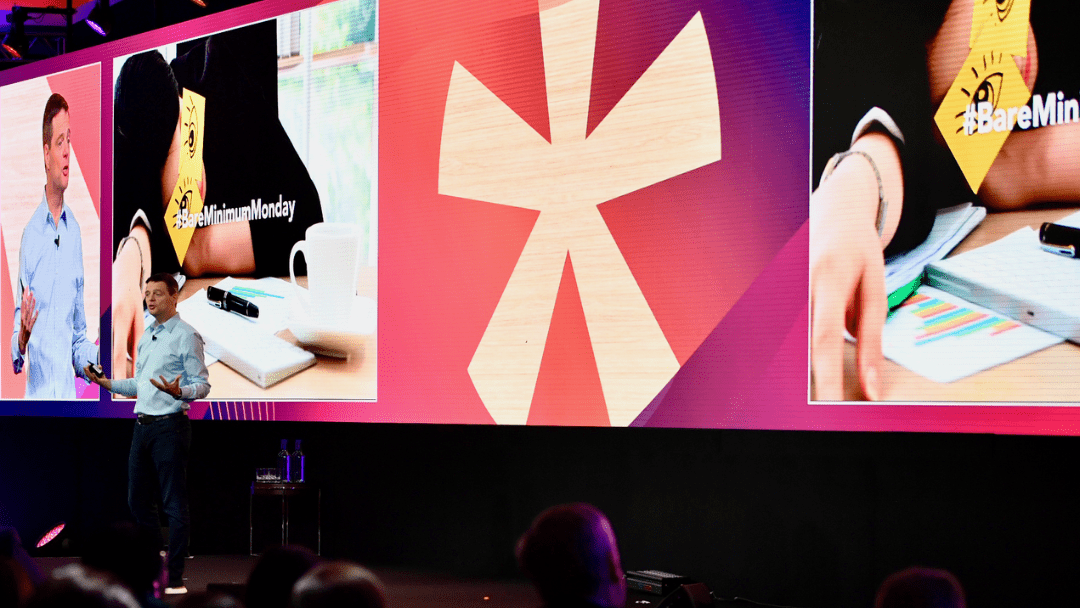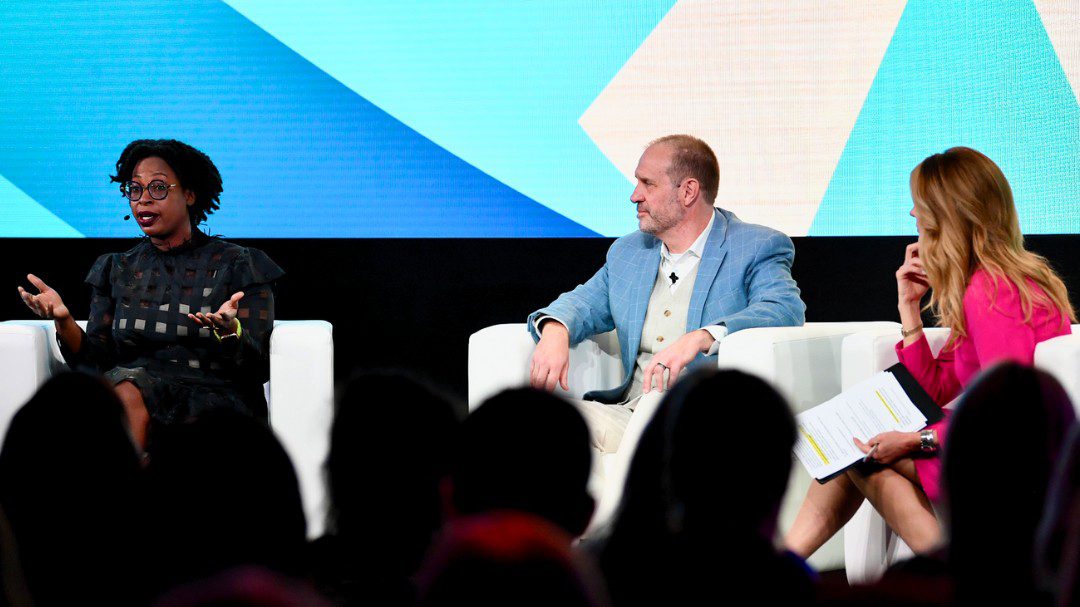Recognition data is an ‘essential source of truth’: Workhuman CEO
UNLEASH was at Workhuman’s Live Forum in London this week.
Event Top Takeaways
Engagement and recognition is a huge challenge for employers, Workhuman president Tom Libretto exclusively tells UNLEASH.
According to Workhuman's data set of 7 million global employers, women typically receive 12% less recognition than men.
What's the secret to success? Leaders from Workhuman and Gallup share all at the vendor's recent London event.
Organizations have “never seen such chaos” – HR leaders have “whiplash” from the three years of complete disruption and change – that’s how Workhuman CEO Eric Mosley kicked off the HR tech giant’s London Forum on 13 June.
For HR, it feels like one step forward, two steps back. Barely a week goes by when there isn’t a new workplace trend going viral on TikTok that challenges HR leaders globally – whether it is the Great Resignation, bare Minimum Monday, quiet quitting, loud quitting, or resenteeism.
For Mosley, the solution here is bringing humanity back into the workplace. “If you can build relationships with your colleagues [and] feel part of a community”, that can alleviate stress, burnout, and nip some of these trends in the bud.
Remember, “people are not the most valuable asset in your company, people are your company. Companies are just individuals and their shared value systems”, stated Mosley.
He added that we don’t just spend our time at work, we spend our lives, and organizations need to acknowledge and appreciate that.
Enter recognition
In an exclusive UNLEASH interview, Tom Libretto, president at Workhuman, agrees with Mosley.
He adds that the main pain point that organizations are facing is around how to keep employees engaged – this is not a new challenge, but solving it is top of mind for employers in this challenging economy and labor market.
For Workhuman, the key to having an engaged workforce – and avoiding costly high attrition rates – is recognition and appreciation.
When employers get this right, with the help of tech platforms like Workhuman, “they’ve seen an enormous return on investment”, in the words of Mosley.

Eric Mosley on stage at the Workhuman Live Forum in London.
The data doesn’t lie. A recent study by Workhuman and Gallup found that when employees are recognized at work, they feel three times more connected to culture, and are more than 30% more likely to stay at the organization for the next five years.
Recognized employees have a much more positive outlook towards work – they are more likely to describe their workplace as fun, friendly, inclusive and caring.
In comparison, those who don’t receive appreciation for their work use words like toxic, bad, boring, stressful.
The issue is that when thinking about engagement and appreciation, many leaders are still stuck in the old-school view that “isn’t that what the salary is for?”, noted Mosley.
But good salaries are no longer enough to retain and motivate people at work – they want to feel valued and connected to something bigger than themselves.
That connection has become a bigger challenge with the advent of hybrid and remote work.
However, Libretto tells UNLEASH that while there is no playbook here, and there is a need for lots of trial and error, for Workhuman, “our philosophy…is that recognition transcends any particular working environment”.
“The need to feel visible, acknowledged, recognized [exists] in a remote environment [and] in a face-to-face environment”.
Engagement, recognition and DEIB
The conversation then turned towards diversity, equity, inclusion and belonging (DEIB).
Having access to data about recognition, through a platform like Workhuman, can help leadership and HR spot the biases – unconscious or otherwise – and nip them in the bud.
The ultimate aim is to ensure there is “equitable treatment of employee populations and cohorts”, Libretto shares with UNLEASH. This explains why chief diversity officers see recognition data as an “essential source of truth” for the companies, Mosley said.
During his keynote, Mosley shared across Workhuman’s data set of 7 million global employers, women receive 12% less recognition than men. He said he found this shocking, but his female peers didn’t.
The language was also different, women were more likely to be praised for team work than their individual contribution.
Dr Meisha-ann Martin, senior director of people analytics and research at Workhuman, added the equity challenge is a major reason why recognition needs to be formalized, and not ad hoc, in organizations.
If you can’t measure it, then the “organization is blind” to biases, and “it never gets fixed”. Leaders need to hold themselves accountable to make real improvement in DEIB.
This explains why Dr Martin sees equity as one of the five pillars of successful recognition programs.
During her keynote session, alongside Ed O’Boyle, global practice leader at Gallup, Dr Martin stated: “I have to feel like if I do something, and my coworker does something, we are equally likely to be acknowledged and recognized for that activity”.
The other four pillars are about ensuring recognition is embedded (aka part of the culture), personalized, authentic and fulfilling.
Dr Martin shared: “If it’s not authentic, it doesn’t work”.
“Recognition is actually a coaching and feedback activity. The more specific you are, the more the person knows about what you want them to repeat. It makes the person a better performer, because they are getting this continuous feedback about what behavior is embedded in the organization’s culture”.
O’Boyle agreed. Recognition needs to be more than just “good job everyone”, it needs to be specific to their job and the business.
Ultimately, for Dr Martin, recognition is about checking in, not just checking on, employees – aka treating them like humans, not just workers.

Dr Meisha-ann Martin, Ed O’Boyle and Emcee Gina London on stage at the Workhuman Live Forum in London.
AI and the future of tech at Workhuman
Ultimately, getting the language and the tone around recognition right is a real challenge.
And this is where recognition technology, like Workhuman, can really help. At WorkhumanLive London, Mosley announced that integrations are a crucial part of the company’s business. One noteworthy example is an integration with OpenAI and ChatGPT.
Mosley shared: “The first thing we did was to attack the problem of a blank white page with a blinking cursor. Time and time again when I talk to people, they’ll say I don’t like to nominate a colleague for an award because I have to write a paragraph of text.
“I just feel icky about it. I don’t want anyone to see if I am a good writer or not, or put my head about the parapet. That blank page is oppressive, it’s an obstacle”.
So, the new integration with OpenAI is called ‘Goodbye Writers Block’, and it essentially helps people overcome the blank page challenge. Of course, they can edit what ChatGPT generates to make it their own, but it is a “really useful technology to help with the friction of people expressing themselves”, according to Mosley.
Reducing friction for employees and organizations around recognition is a core part of all innovation at Workhuman, according to Libretto.
While the OpenAI partnership is a great example of this, for Libretto, so is embedding recognition into the flow of work through a Microsoft 365 integration.
Dr Martin is very clear that AI will not replace human input in recognition.
“The purpose of AI is only to get you started”, but, given that authenticity and specificity are so key to successful appreciation strategies, “I don’t think there’s any danger of the manager becoming obsolete here”.
The edit is where individuals can personalize and show that the appreciation is genuine.
Let’s end with Dr Martin: “Recognition changes hearts and minds, it changes how people feel and what they do. It is the engine that helps businesses thrive”.
Sign up to the UNLEASH Newsletter
Get the Editor’s picks of the week delivered straight to your inbox!

Chief Reporter
Allie is an award-winning business journalist and can be reached at alexandra@unleash.ai.
